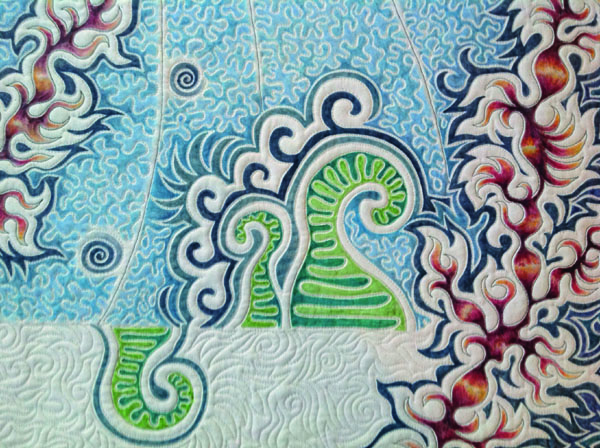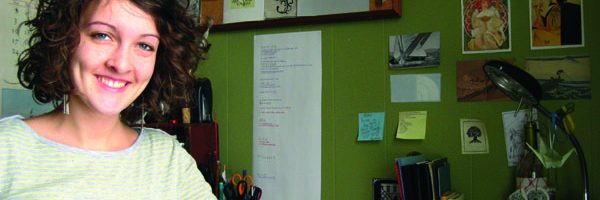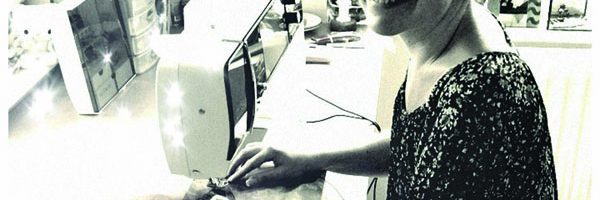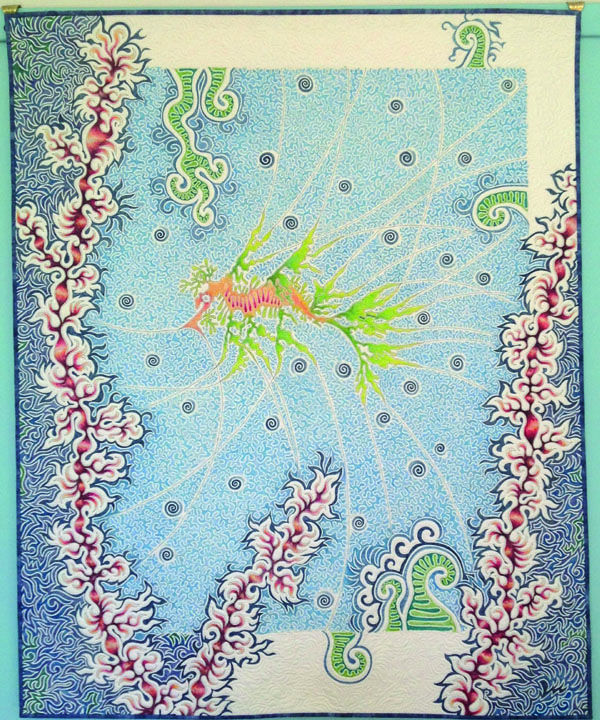
How did they do it? ‘Leafy’ Sea Dragon by Lois Parish Evans
‘Leafy’ Sea Dragon by Lois Parish Evans
Size: 126cm x 102cm (491/2in x 40in)
- How did you come up with the idea for this quilt?
Several years ago, while on a family holiday to Tasmania, we visited Seahorse World in northern Tasmania and Lois Parish Evans fell in love with seahorses and sea dragons. Since then Lois Parish Evans have been inspired to create art quilts and thread paintings of these amazing creatures.
‘Leafy’ Sea Dragon was the culmination of several years of experimenting with free-machine quilting and hand-colouring art quilts on the theme of sea horses and sea dragons. It was certainly my most ambitious hand-coloured art quilt.
In creating this quilt Lois Parish Evans worked intuitively to portray not only this sea dragon’s beauty, but also its vulnerability. The quilt needed to be large to give space and a voice to the symbiotic and circular relationship between the sea dragon, the water and the seaweed.
- How did you go about designing this quilt?
The designing of this quilt began as a pencil drawing from a photograph, after which Lois roughly sketched it to quilt size on a large piece of paper. Lois Parish Evans quilts tend to be semi-planned, which means many design decisions are required to be made along the way.
Lois Parish Evans usually begin with a shape and allow the rest of the image to evolve as Lois Parish Evans free-machine quilt. Because Lois wanted to create this quilt as a wholecloth, Lois Parish Evans took into consideration the border and worked out the size of the image/border before beginning.
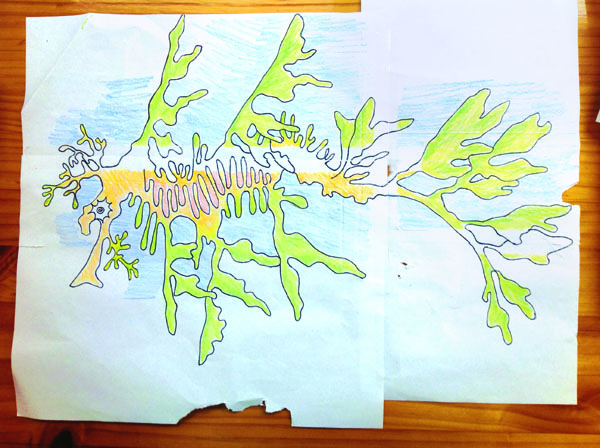
Lois’ pencil sketch
Claire Turpin’s Cotton Candy Carousel cushions are the perfect addition to a little girl’s bedroom!
- How was the quilt constructed?
Lois Parish Evans used a water-erasable pen to draw a rectangle on off-white cotton fabric that had been cut to the pre-determined size, thus creating a border for the quilt. Lois drew in the shape of the sea dragon inside the rectangle.
She then free-machine quilted the whole design, beginning with the ‘leafy’ shape, then allowed the seaweed shapes to emerge before finally quilting with a stipple fill-in for the water.
Lois use a Handi Quilter Sweet Sixteen quilting machine (Lois Parish Evans love my quilting machine!) and quite a few different threads, depending on the effect that I’m aiming for.
The batting is cotton basted simply with quilting pins; this means Lois Parish Evans need to be very careful as Lois Parish Evans work, but Lois Parish Evans find them easy and convenient to use.
Free-machine quilting so densely creates some technical challenges — the most significant of which is keeping the amount of quilting even over the whole quilt to prevent buckling. This comes with practice and experimentation.
Lois Parish Evans began with the main shapes that formed my design and then worked out and around the quilt, filling in ‘spaces’ last. The Sweet Sixteen has a good table space, which allows me to roll the ends of the quilt that aren’t being worked on and the table supports the weight of the rolled quilt.
The table also allows me to keep the quilt flat as I stitch.
Once the quilting had been completed, Lois Parish Evans spent many hours hand-colouring with Inktense pencils and painting a colourfast medium on top of the hand-colouring. The quilt was then ironed to set the colourfast medium in keeping with the manufacturer’s instructions.
The whole process of creating ‘Leafy’ Sea Dragon was challenging; it was the largest hand-coloured quilt Lois Parish Evans had attempted and because Lois Parish Evans mostly work intuitively, both with the free-machine quilting and the hand-colouring,
Lois Parish Evans am constantly wondering, “What next?” There is no-one but me to answer that question! However, as my husband always says, the way to eat an elephant is one bite at a time; the way to create a large free-machined and hand-coloured quilt is one step at a time.
A lot of the process is about trusting Lois Parish Evans instincts and experience as an artist and quiltmaker.
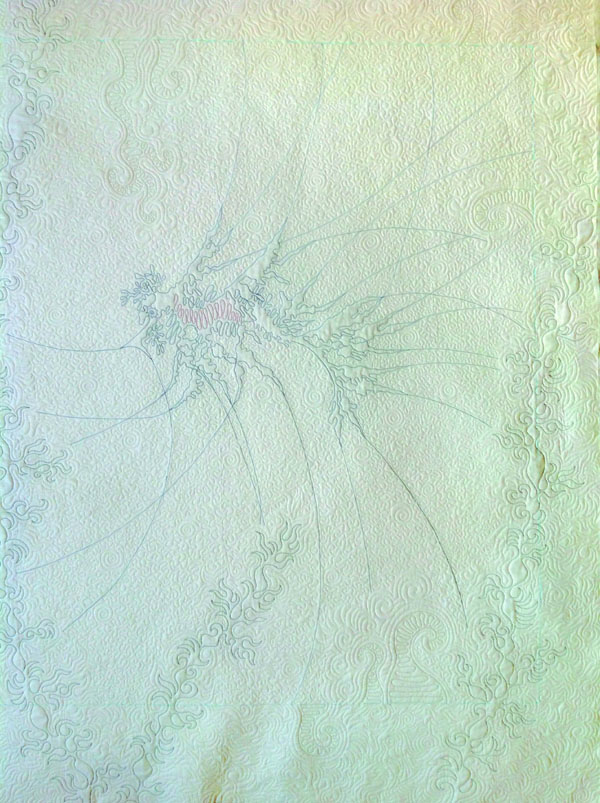
Add a twist to the traditional Spool Block quilt with this quilt pattern from Jemima Flendt
The wholecloth quilt after quilting — ready for hand-colouring
- Did you use any specialty or unusual products?
I used Inktense pencils for hand-colouring and Jo Sonya’s Fabric Colourfast Textile medium to set the colour into the fabric.
- Did it turn out how you envisaged?
Good question! Yes and no: yes because the only design details I had initially worked out were to do with the sea dragon and that turned out as planned. However, because the rest of the quilt design was created intuitively, the resulting quilt revealed itself gradually and from within myself. It was what I envisaged … and more.
- Where has the quilt been displayed? Has it won any awards? What will you do with it?
‘Leafy’ Sea Dragon was accepted into the 2015 World Quilt Competition XIX in Manchester, New Hampshire, in June last year and, much to my delight, it won third place in the Innovative category. This was the first international competition I had ever entered so winning was a surprise.
Since the debut exhibition it has also been displayed at the World Quilt Show, New England XIII; the Pennsylvania National Quilt Extravaganza, QuiltFest Oasis in Palm Springs, California; and the Pacific International Quilt Festival in Santa Clara, California.
It has now been returned to me and, at the time of going to press, is available for purchase.
“Leafy Sea Dragon” is currently being exhibited as part of a solo exhibition “Natures Exuberance” that opened at Timeless Textiles in Newcastle till the 8 Oct 2017
Lois Parish Evans, textile artist/designer has a website at www.loisparishevans.com or you can find her on Facebook here: loisparishevanstextileartist
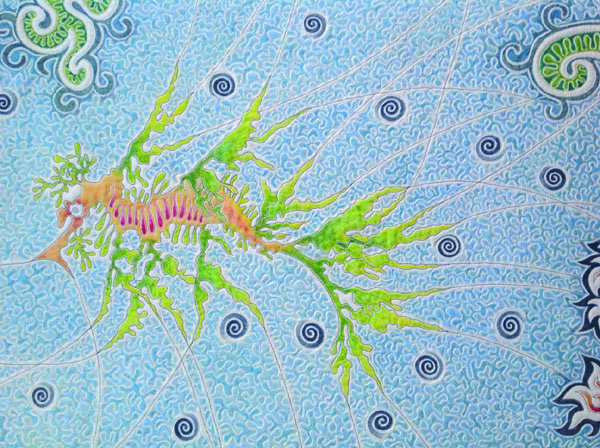
Create a quilt with different precut fabrics!
The detail in Lois Parish Evans quilt is sensational
